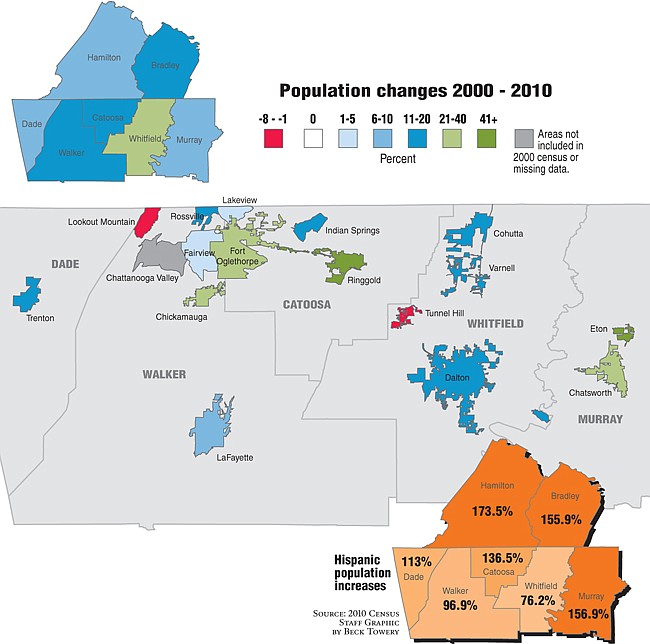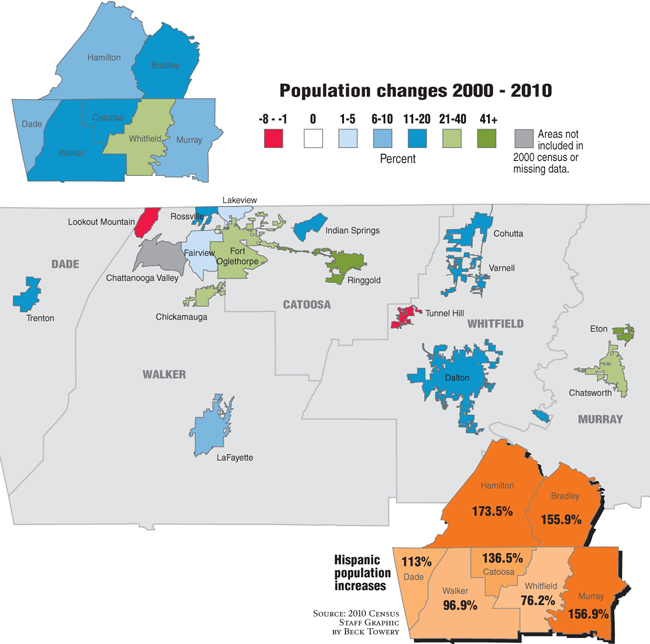Nearly half of the people in Dalton and one out of three in Whitfield County are Hispanic, according to new information from the 2010 census.
But increases in the Latino population are only a part of a wave of growth in Northwest Georgia.
Catoosa, Gordon, Whitfield and Gilmer counties all saw their populations swell by more than 20 percent between 2000 and 2010, according to Georgia data from the 2010 census released Thursday.
Many cities showed even greater growth than the counties with Ringgold, Fort Oglethorpe and Chickamauga growing by 48, 33 and 38 percent respectively in the past decade.
Catoosa County Commission Chairman Keith Greene said quality of life and low taxes are part of what is driving the people to North Georgia.
"I think we have a great area to raise families," he said.
Whitfield County Commission Chairman Mike Babb said he's not surprised to see significant growth, but was surprised to see the county's population went over 100,000.
Looking around the region he said he would not have expected for Whitfield to have grown more than Catoosa, but echoed Greene's ideas as to why the area is experiencing a boom.
"We've got all of the reasons for this to be a good place to live," he said.
The seven counties in extreme Northwest Georgia added 53,000 people for 16.8 percent growth. The state grew by 18 percent, adding 1.5 million residents.
State Sen. Charlie Bethel, R-Dalton, who represents Murray and Whitfield counties, said the connections between growing Atlanta and Chattanooga as well as the carpet-related jobs have made the area strong, even in a recession.
"It's a continuation of a trend over at least the last three decades," said Bethel of growth in the Southeast. "The biggest factor is the same factor that it's always been: we're a manufacturing community."
But the surge of Hispanics brought led to some of the biggest numbers in the census data set.
Whitfield County had Georgia's highest percentage of Hispanic residents for the second census in a row. Gordon and Murray counties also ranked among the top 15 in the state for Hispanic populations.
Murray County led the way for Latino growth, more than doubling from 2,000 Hispanics in 2000 to more than 5,000 in last year's census. Catoosa, Dade, Fannin and Gordon counties also saw their Latino populations double.
As a whole, the state Latino population nearly doubled between 2000 and 2010 and now stands at more than 850,000.
Jerry Gonzalez, executive director of the Georgia Association of Latino Elected Officials, praised outreach efforts within the Hispanic community to encourage participation in the census.
In a prepared statement, he said he hoped the growth would lead to a stronger voice as state and federal lawmakers redraw district lines later this year.
Gonzales wrote that his group would work with legislators "to ensure Latino interests will be able to influence future elections at the congressional, state legislative and local levels of government."
Growth, no matter in which segment of the population, comes with a burden. During the 10-year span, local governments have run expensive sewer lines, added lanes to roads and built new fire stations and schools to keep up with the growth.
"Hopefully we'll have everything in place to keep up with that demand," said Greene.
The population count may have an immediate impact on Whitfield County, according to Babb, because counties with six-figure populations have to abide by certain restrictions that smaller counties do not.
"I was kind of hoping we'd stay under 100,000," he said.
And growth can be even trickier when it involves a language barrier.
Babb acknowledged that growth among non-English speakers would have an impact on the school system, but attempts to reach various school officials in Whitfield and Murray counties were unsuccessful Thursday evening.
For Whitfield County, Babb said, the overall growth was a bigger planning issue than any particular demographic shift.
"As far as the county maintenance, people are people," he said.
In Dalton, Bethel said the statistical ethnic breakdowns can make things seem complicated, but really most residents are looking for the same thing.
"There are a lot of things where its easy to fixate on differences and try and figure out what that means," he said. "Our Hispanic population wants the same thing that our Caucasian population or our African-American population or our Asian population wants-they want a place where they can raise their family in a good situation."

